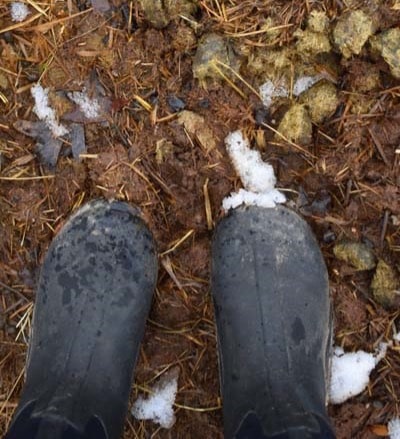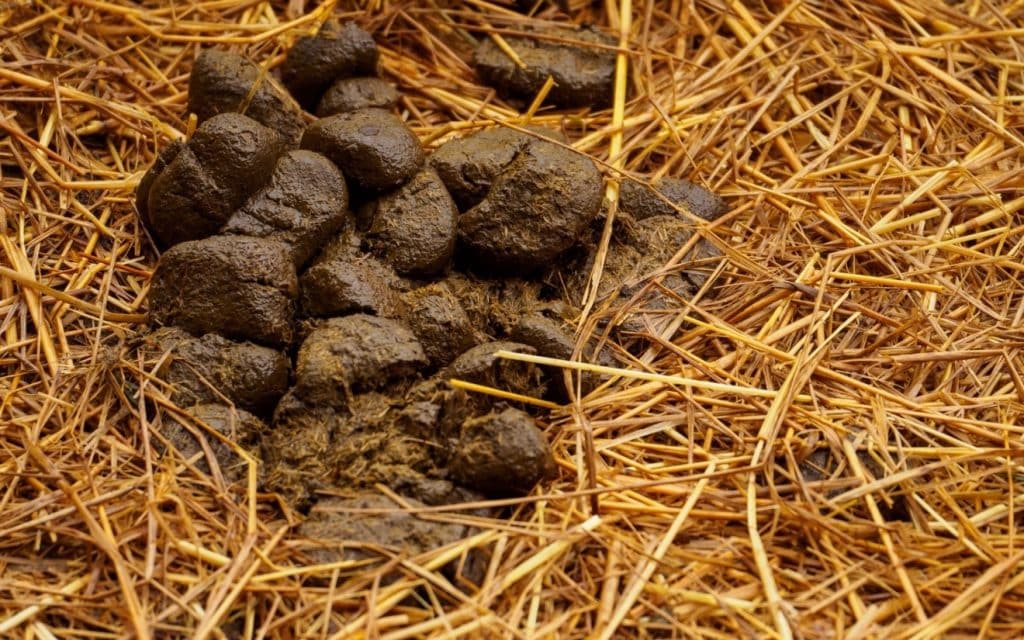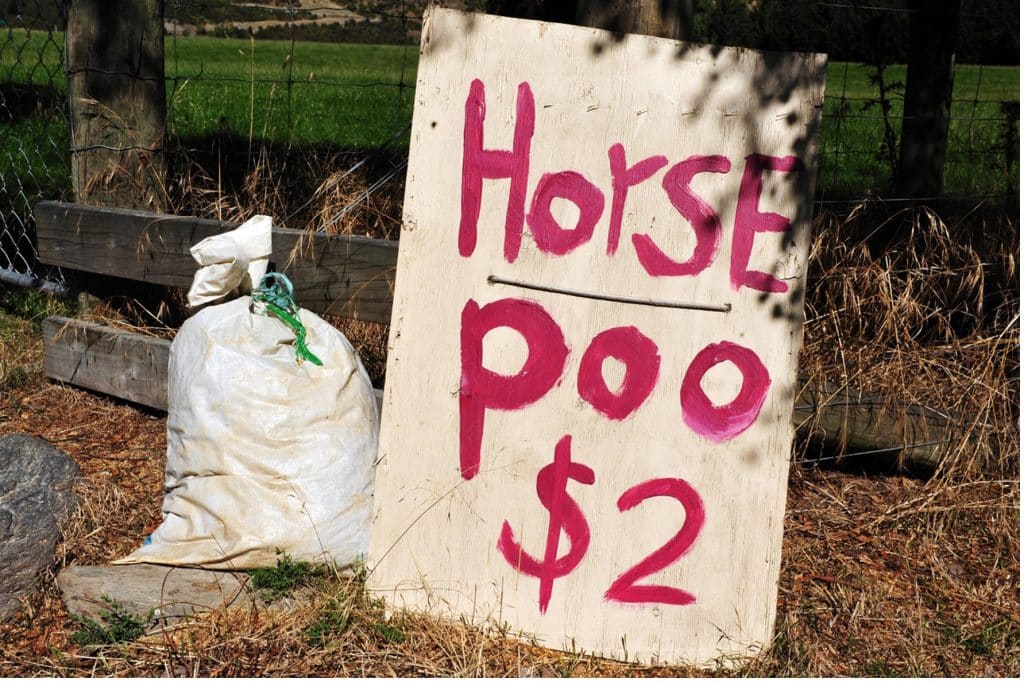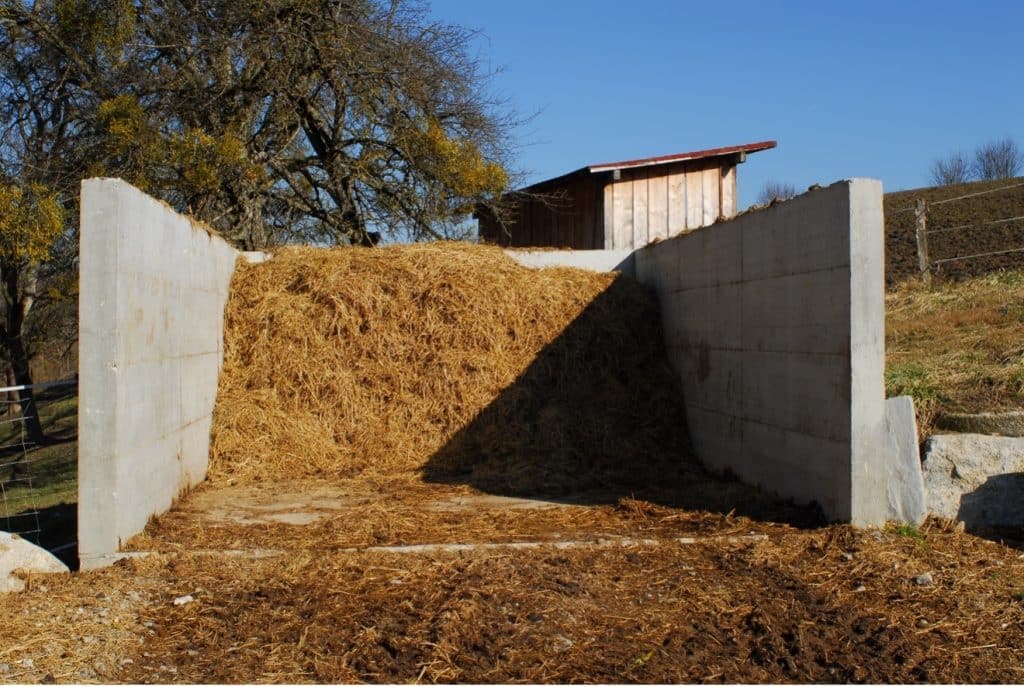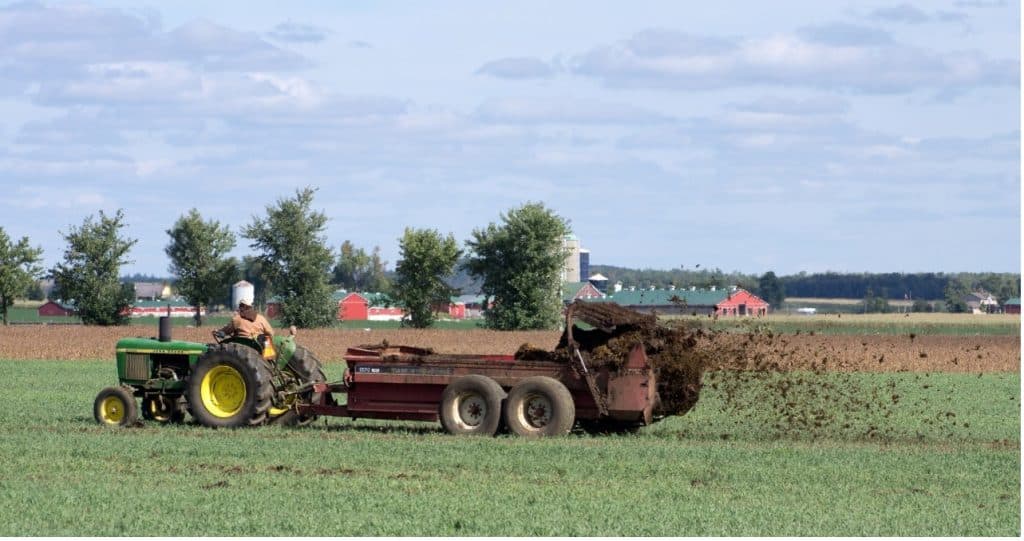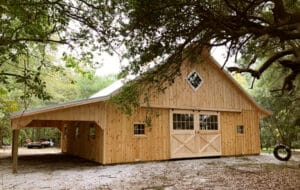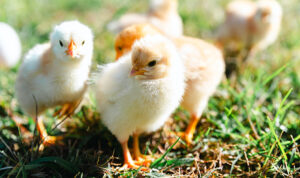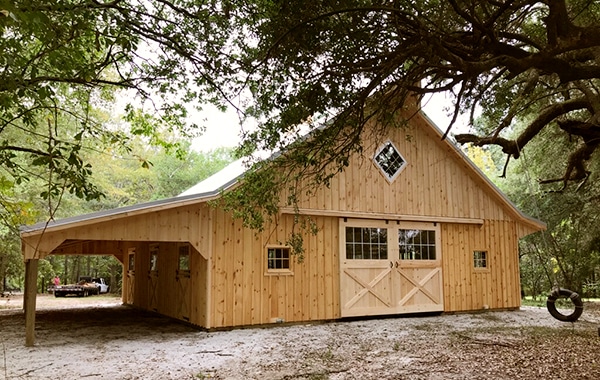Horse people know that mucking about with horse manure is part of everyday life in the care of their charges. The work is laborious and time-consuming.
It is hard for the non-horse aficionado to contemplate the amount of energy and attention the task requires or to understand the horse owner’s enthusiasm with the result of their cleaning efforts or seemingly weird attention to the smelly piles of manure that accumulate in the stable.
The large Equus critter naturally poops and pees in large volumes. All this mess requires some serious horsey housework to keep the stalls and pastures clean and tidy. Especially when you consider how much the average of 30 pounds of poop per horse per day can add up. A horse manure management protocol is best done as part of the horse facility set up and design.
Non-horsey types may not mention their equestrian friend’s special ‘Eau d’Equus’ while the horse caregiver will barely notice their special aroma. Horse poop inadvertently collected on the sole of their shoes to be later deposited on kitchen floors or car mats warrant little attention.
Onlookers to equestrian lifestyle are not intrigued by horse manure the way savvy horse owners usually are – experienced horse folks are obsessed with how many piles of manure are found in the stall after a horse has been stabled for the night. The natural form, quantity, consistency, and color of the manure are great indicators of the health of the horse. Even the arrangement and placement of the piles of black gold around the stall are helpful indicators of the health of the animal. These can detail the restlessness or mood of the horse and its mental health.
Horse caregivers don’t mind scraping manure off windowsills, emptying water buckets full of floating manure balls, sponging poop stains off our horses’ coats or back ends, or washing down stall walls decorated with muck. If that is not enough the ardent horse lover will also be seen dragging endless skips laden with heavy manure. They will spend hours and hours each day on mucking out chores, sieving poop and pee from the stall bedding. Back breaking quantities of the stuff will be pushed in wheelbarrows up steep hills or rough ground to manure pits or to machines that will scatter the poop elsewhere later.
It must seem odd to the non-horse person that sometimes the diligent horse person will even collect fresh manure samples up and stuff them into small plastic containers and then mail them out to other people who apparently share their interest in the contents. Bizarre behavior indeed.
People have also witnessed horse aficionados wandering around in fields picking up even more of the manure. Collecting it up and wheeling it elsewhere. Equestrians can become dizzy with excitement at the idea of owning a horse poop vacuum or a mechanical manure shaker device.
All this bonkers behavior comes perfectly naturally to the horse person, yet despite their cognizance of all things horse manure and myriad of interesting displays of attention to its presence, you do have to wonder, where does it all go?
A Hole In The Ground
Dog owners are probably familiar with the large plastic buckets that can be buried in the backyard and treated like chemical toilets for composting their pet’s poop provisions and keeping the lawn clear of poop mines.
Plastic bag poop pick up detail when walking the dog in urban areas is the norm. Though this has its drawback in some countries such as the United Kingdom, where these bags of delight are commonly tossed over hedgerows into fenced pastures and ingested by grazing horses often resulting in death from colic. Old mailboxes are commonly used in rural areas as the new rubbish bin for disposal of these bags of poop and picked up somewhat irregularly by town council services.
A plastic bag pick up is not particularly useful for horse poop and hanging a sack behind a horse’s rear end to collect the deposit when the animal is walking on the road is rarely seen except in larger cities.
A large hole in the ground is rarely the resource utilized by horse owners for their horse manure disposal either. Although when visiting the Spanish Riding School in Vienna when it was at the Hofburg Palace complex, this author did note such a method was used in their back courtyard.
Where There’s Muck
Where there is muck, it is said there is money. While of course this expression is not literal and suggest collecting horse manure for sale is a profitable enterprise, but selling horse manure for profit is possible. Bagging up manure is a tiresome process and some gardeners that may purchase it prefer it to be already composted.
In my early career in England, I rode at the urban Dulwich Riding School, in South London. They had a useful arrangement with Dulwich Park to supply all their beautiful rose beds with horse manure and by return the large circular sand track that surrounded these huge gardens was made available for the riding school patrons to use to exercise the school horses. A jolly amicable arrangement and a win-win situation, especially for this country girl who was used to the endless miles of bridle trails and open fields in the very horsey county of Buckinghamshire.
On my travels elsewhere as a clinician in the U.S.A, I noted innovative barn owners had made a deal with a large supermarket chain that produced its own grocery produce to leave a 20-yard dumpster by the back door of their commercial boarding business’s center aisle barn. The manure was ‘harvested’ once a week and conveniently disappeared to a true recycling effort.
Don’t Pooh-Pooh Poop Plans
Amazingly, horse manure disposal is often overlooked in horse facility plans. When designing your horse yard, be it a big or small operation, collection, handling, and disposal of manure should be considered in the plans for the type and size of the facility.
Here are some questions to address:
- What is the width, height and door access needed of an aisleway for tractors or mechanical means for manure transport?
- What will the route of ingress and egress be in poor weather to both the interior of the structure and the manure storage area?
- Where will manure be stored when snow obstructs the usual place of disposal such as a manure pit some distance away from the barn?
- Will the horses be mainly stabled with turn out or have in/out freedom from stall to a fenced area outside? If the latter how will the outdoor area be accessed and cleaned of manure? If the former, how will paddocks be accessed and kept picked of manure?
- Will pasture management include harrowing in hot weather to disperse manure (hot weather is best time to do it for worm/parasite control)?
- Where will the equipment for manure transport and disposal be safely stored?
- If composting the manure where will the pile be located for access for adding other ingredients.
- If composting the manure, which method will be used?
But there are many more issues to mull over for manure management. While composting done correctly (there are many different methods of composting) can be an eco-friendly solution for this rich fertilizer, there are certain caveats to handling and storing the manure that should be considered.
The Manure Pit or Pile
As manure piles may attract ‘rats as big as cats’ as my grandmother used to say, mice, snakes and other wildlife, placement of the manure storage or composting area should be distant from the horse housing and any residential buildings on the property. It is also a haven for biting insects, flies, and other pesky bugs, so for obvious reasons removing manure away from where horses graze or areas they inhabit is also a sound idea.
As if that isn’t enough issues with which to contend, a manure pile also presents a fire hazard, so its placement should not be close to buildings, lines of trees or other areas of combustible materials such as propane storage tanks or motorized equipment. There are also likely restrictions as to how close to a property boundary or water resource such as a stream or river, the manure pile may be sited. Check with your town for any special ordinances.
The run-off from manure piles can contaminate wells and other water resources. Grading the site of the manure pile away from these resources with a gentle slope with can help defray the problem, but for obvious reasons run-off from the manure pile with its inherent phosphorous and nitrogen components and its ever-present bacteria, parasites and viruses should be placed at least 100 feet from any water resource.
Thankfully horse manure is exempt from EPA solid waste regulations as it does not contain a sufficient quantity of chemicals to be considered hazardous to the environment or to humans. This does not mean that you should store manure without some care and attention even if your town ordinances don’t require its removal to a landfill.
If the stalls are to be mucked out with a manual indoor transport option such as a wheelbarrow or skip, then the material will need to be transported once outside the building by some mechanical means if the manure pit is sited some distance away. Tractors with either a bucket on a front loader or a pull behind trailer, ATV pulling a plastic or metal trailer, UTV’s with a dump bed will all complete the transportation task and handle the rough terrain that is likely the route to the manure pile site.
Bear in mind that during wet weather such well-used routes may become muddy tracks and hard to navigate. The addition of a roughly laid gravel or stonedust surface can aid in keeping the area free of muddy mayhem.
Note: If the manure is to be picked up by a tractor bucket for removal later either to a manure spreader to scatter it on the fields, or for disposal into a dumpster for pick up, then it is a good idea to lay a concrete pad surrounded by a concrete wall or similar substantial surrounding on 3 sides, so the area can be easily cleared of manure.
Disposal Services By Dumpster
Certain states e.g., Massachusetts, have a legal requirement that all horse manure be disposed of via dumpsters and not be held on the property as compost. This burden can be onerous for the horse property owner in both expense and access requirements for large equipment to pick up/drop off dumpster service.
It is prudent to research legal special requirements for your neighborhood before embarking on building or developing your horse property.
Spread and Scatter
The manure spreader can be a handy option to dispose of the material if you have the appropriate acreage where it can be recycled.
Manure spreaders come in all shapes and sizes. Some are small enough to be pulled by a UTV while others require the sincere PTO power of a large tractor. Ground driven versus machine driven options differ slightly in their risk to the operator or user of injury.
Whatever option is chosen be aware that as with any farm machinery, the equipment should never be run by anyone that is not seated and belted in the cab or in the seat of the tractor. Additionally loose clothing such as baggy T-shirts or pants, or uncuffed long-sleeved shirts should never be worn around equipment, as the fabrics can be drawn into chains and moving parts of the machine by accident, resulting in serious injury or even death to the individual.
It is also not a good idea to have a narrow board ramp up to the top of the spreader or park it at a lower level than the barn to facilitate tipping of wheelbarrows or containers into the machine, as injury from accidents such as people falling off the ramp or even into the unit may occur.
Note: If the manure is to be picked up by a tractor bucket for removal later (either to a manure spreader to scatter it on the fields, or for disposal into a dumpster for pick up), then it is a good idea to lay a heavy-duty concrete pad surrounded by a concrete wall or similar substantial surrounding on 3 sides, so the area can be easily cleared of manure.
Burn or Bury
Covered storage options such as burying manure can increase the speed at which manure breaks down. Recycling manure using an anaerobic digester is sometimes used in large farm operations to produce a biogas that can then be used to generate electricity. This is not a realistic option for the average scale horse facility.
Other covered storage methods should always be used with caution as during the decomposition of manure methane will be produced. Without due attention to ventilation in a contained storage space there is always a risk of suffocation from lack of oxygen caused by the displacement of oxygen used and the carbon dioxide produced during the decomposition process.
Final Remarks
Smart barn designs and horse manure management solutions are obviously essential for an efficient daily work routine around the horse barn.
Choose to work with an experienced barn construction company so you can enjoy much free advice on everything from what size aisles are needed for what equipment, how the site preparation can be adjusted to include apron areas for good traction and access and how to solve the manure management issue.
There are many styles and designs available in horse barns and there is a myriad of options that will fit into small spaces as well as larger builds for commercial facilities. Selection of a barn builder that has a variety of styles of structures gives you great flexibility in what you can choose from not just in aesthetic appeal, but also to fit your budget and daily lifestyle needs.


